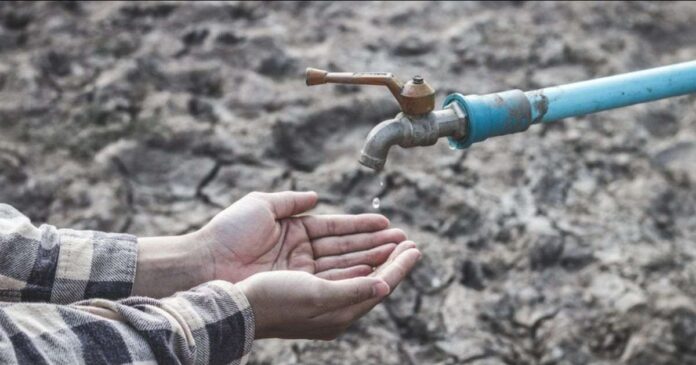Pakistan is currently facing a severe water crisis with many parts of the country experiencing acute shortages of water. According to reports, the water crisis has affected virtually all sectors of the economy, including agriculture, industry, and domestic use.
With an estimated 220 million people in 2021, the country is already facing a per capita water availability that is significantly below the global average. Moreover, the situation is expected to worsen, as the population is projected to reach 400 million by 2050, according to the United Nations.
The Pakistan Council of Research in Water Resources (PCRWR) warns that the country is on the brink of becoming a water-stressed country due to its growing population and increasing demand for water. According to the United Nations Development Program (UNDP), Pakistan ranks 80th out of 81 countries in terms of access to safe drinking water and sanitation. This ranking highlights the country’s poor state of water supply and sanitation facilities. The lack of access to safe drinking water is a severe public health issue, which leads to the spread of water-borne diseases, resulting in thousands of deaths each year. The situation is particularly dire in rural areas, where people rely heavily on contaminated water sources.
The issue of water scarcity is further exacerbated by climate change, which has led to irregular weather patterns and extreme weather events, such as floods and droughts. According to the Pakistan Meteorological Department, the country has been experiencing more frequent and severe droughts since the 1990s, with a particularly severe drought occurring in 2021. So, climate change is one of the primary causes of the water crisis in Pakistan. Rising temperatures, changing weather patterns, and melting glaciers are affecting the country’s water supply. According to a report by the PCRWR, the water inflow in the country’s major rivers has decreased by 30 percent due to climate change. This reduction in water inflow is affecting agriculture, hydropower generation, and other sectors that rely heavily on water. Moreover, Pakistan is the eighth most climate-vulnerable country globally, and extreme weather events such as floods and droughts are becoming more frequent due to climate change. These events are damaging the country’s infrastructure and disrupting the water supply, leading to further water scarcity.
Pakistan’s rapidly growing population is also contributing to the water crisis. The population has increased from around 34 million in 1951 to more than 220 million in 2021. As a result, the demand for water has skyrocketed, and the water supply is struggling to keep up. In addition, the population growth has led to urbanization, which has put additional pressure on water resources in cities. First, the increased demand for water for domestic purposes, such as drinking, cooking, and washing, is straining the country’s water supply systems. According to the PCRWR, the per capita availability of water in Pakistan has declined from 5,260 cubic meters per person in 1951 to 1,017 cubic meters per person in 2021, which is well below the internationally recommended threshold of 1,700 cubic meters per person per year.
Second, the growing population is increasing the demand for water for agriculture, which is the largest user of water in Pakistan. Agriculture accounts for around 90 percent of the country’s total water consumption, and the demand for water for agriculture is expected to increase as the population grows. This is putting pressure on the country’s irrigation systems, which are already facing challenges such as waterlogging, salinity, and inefficient water use practices. Third, the growing population is also increasing the demand for water for industrial purposes, such as manufacturing, mining, and energy production. The industrial sector is expected to be a major driver of economic growth in Pakistan, and as the sector grows, so too will its demand for water. This is putting pressure on the country’s already limited water resources, which could lead to conflicts between different users of water.
Mismanagement of water resources is another major cause of the water crisis in Pakistan. The government and other stakeholders have failed to implement efficient water management practices, resulting in the wastage of water and inefficient distribution of water resources. For instance, Pakistan loses around 35 percent of its water supply due to leakages in the irrigation system and inefficient water management practices. Moreover, illegal water connections and the uncontrolled use of groundwater are contributing to the depletion of groundwater reserves, exacerbating the water crisis.
Pakistan’s economy is heavily reliant on the agriculture sector, which employs around 42 percent of the country’s workforce. However, the water crisis is affecting agricultural production, leading to reduced crop yields and increased food prices. According to the PCRWR, around 90 percent of the country’s agricultural land depends on irrigation, and the reduced water supply is affecting crop productivity. As a result, the agriculture sector’s contribution to the country’s GDP is decreasing, affecting the livelihoods of millions of people. The World Bank estimates that the water crisis is costing the country around 1.5 percent of its GDP every year.
The international community can provide technical expertise to assist Pakistan in developing innovative solutions to the water crisis. Technical expertise can include support for water management, irrigation systems, groundwater management, and water treatment technologies.
The water crisis is also affecting the industrial sector, which is crucial for Pakistan’s economic growth. The industrial sector accounts for around 20 percent of the country’s GDP and provides employment opportunities to millions of people. However, the reduced water supply is affecting industrial production, leading to lower output and higher production costs. According to the State Bank of Pakistan, the water crisis has reduced industrial output by around 30 percent. This reduction in output is affecting the country’s exports and reducing the foreign exchange earnings.
Also, Pakistan’s energy sector heavily relies on hydropower generation, which accounts for around 27 percent of the country’s total power generation. However, the water crisis is affecting the hydropower generation, leading to power shortages and higher electricity prices. The power shortages are affecting the industrial and commercial sectors, leading to reduced production and increased production costs. According to the Pakistan Water Partnership, the water crisis is causing a loss of around $2 billion annually to the energy sector.
The uncontrolled use of groundwater is causing the depletion of groundwater reserves, leading to reduced water availability for irrigation and domestic use. The reduction in water supply is affecting the ecosystem, leading to soil erosion, reduced biodiversity, and degradation of aquatic ecosystems. The water crisis is exacerbating climate change, as the reduced water supply is affecting agriculture, leading to reduced carbon sequestration and increased greenhouse gas emissions. According to the PCRWR, the country is losing around 7 million acre-feet of water annually due to the depletion of groundwater reserves. This depletion is leading to increased water scarcity, affecting millions of people’s daily lives.
Pakistan dumps water worth $22 billion into the sea every year mainly because of lack of storage capacity and poor conservation practices. That is why efficient water management practices are crucial for addressing the water crisis in Pakistan. The government should prioritize efficient water management practices, such as drip irrigation, water conservation, and recycling, to reduce water wastage and increase water use efficiency. Rainwater harvesting is an effective technique for increasing water availability. The government should encourage rainwater harvesting at the community level and promote the installation of rainwater harvesting systems in buildings. The government should implement a water pricing system to incentivize efficient water use and discourage wasteful practices. The pricing system should be based on the principles of equity and affordability to ensure that low-income households have access to affordable water. The government should invest in improving water infrastructure, including water storage facilities, irrigation systems, and pipelines, to ensure the efficient distribution of water.
Groundwater management is critical for addressing the water crisis in Pakistan. The government should implement a groundwater management system to regulate groundwater extraction and recharge, promote efficient use of groundwater, and prevent groundwater contamination. Public awareness campaigns are essential for promoting efficient water use and conservation practices. The government should launch public awareness campaigns to educate the public about the importance of water conservation and efficient water use.
The private sector can play a vital role in addressing the water crisis in Pakistan. The government should encourage private sector participation in water management, such as water treatment, desalination, and wastewater management. Finally, Research and development are crucial for developing innovative solutions to the water crisis in Pakistan. The government should invest in research and development to develop new water technologies, increase water use efficiency, and promote sustainable water management practices.
Apart from that, the international community can provide technical expertise to assist Pakistan in developing innovative solutions to the water crisis. Technical expertise can include support for water management, irrigation systems, groundwater management, and water treatment technologies.
Thus, the implementation of these recommendations through collaborative efforts by the government, private sector, and civil society can help address the water crisis and ensure sustainable water management practices for Pakistan’s future.























